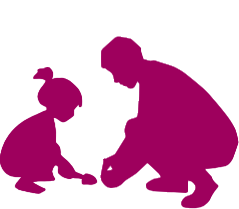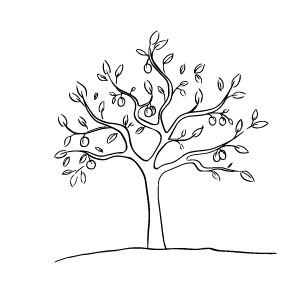Words are powerful. They set a scene. They build a story. They shape relationships, situations and people.
So when my daughter’s therapists started each session by asking about challenges since our last appointment, I would tell them. What I didn’t realise was that the words I was using – the story I was building – was chipping away at my daughter’s self-esteem.
A change would come over her when I gave the update. Her body drooped. She would play quietly, not, looking at us but still listening.
She would sometimes repeat things I’d said, but mostly she would say angrily, “Mummy! Stop talking!”
We had several therapists at that point, which meant we all went through this multiple times a week, and my daughter’s self-esteem started to spiral down.
Reducing my mental load
It wasn’t just my daughter who was suffering. I was finding it hard too.
My mental load was already stretched from being a working parent, but added to that was the additional – and often invisible – demands of being a special needs parent. I was trying to do my best remembering what I’d said to which therapist. Sometimes I repeated stories to one therapist while forgetting to tell others.
It didn’t take long to see that face-to-face sharing wasn’t working for us. It was time to think differently about how we communicated.
A new way of sharing
I did some thinking and talking to others. I decided to try a collaboration app.
I did some research and ended up finding an online collaboration tool called Slack, which is a bit like a social media sharing space. Slack is a private space so members need to log in, which was a requirement for some of our therapists. I also control who joins and leaves the group.
Slack has a newsfeed for posts, photos and videos. I can tag people, and I can share information to everyone in one large group or to smaller sub-groups.
How we make it work
I set out a clear purpose for the Slack group so that the members knew why it exists and what I wanted to achieve: Sharing day-to-day challenges and achievements in here, so as to build self-esteem out there.
I post on the same day every week so members know when to expect an update. I share challenges, achievements, goals and, when appropriate, documents. I also use it to ask questions, for ideas, and to help find or create resources. Tagging people is also useful so they know if some information or question is there specifically for them.
I started posting in paragraphs at first, but over time I realised that if I use subheadings then it’s easier for members to scan the content and find what’s most relevant to them.
I don’t put everything on Slack. I still use emails for anything confidential that I don’t want to share with everyone.
What I have found though is that the more we share openly, the more everyone in my daughter’s team is able to work toward the same goals and to provide support across their disciplines. Also, unlike emails, when a new member joins they can read the historical posts.
Who’s using Slack
While at first, I set up a Slack channel to share with my daughter’s therapists privately, over time I have invited many of her other supports into this group: her paediatrician, school and dance teachers, and her after school carer.
I have found that everyone has benefited greatly from the app, as they each use different snippets from the posts to strengthen their relationship with my daughter.
While each of the support team works independently with my daughter, the app has allowed for more consistency in how they do this. The supports can also lean on each other when needed too.
Here is what my daughter’s dance teacher says about using Slack to communicate
As a dance teacher, I’m invested in my student’s success, not just in terms of dance, but socially, emotionally and cognitively. When I heard about the idea to start up a method of communicating between parents and therapists I was beyond keen to be a part of it.
In its most simple form, using Slack gives me a greater connection to my student’s needs, goals, current struggles and what she’s engaging with right now. The more I know, the more I can cater my lessons to be as beneficial as possible.
There are three key ways that using a communication platform benefits me as a dance teacher, and therefore benefits my students.
Time
As a business owner, dance teacher and PhD candidate, time is not something that is easily come by. Like many other teachers, I’m often running between classes, lesson planning, admin, and somehow trying to fit my own personal life in there too. We all want the best for our students, but there are finite hours in a day. Using Slack saves precious time. It avoids the need for meetings or regular catch-ups. I can catch up on my student’s progress and current needs whilst walking my dog on Monday morning. While I may not always have time to comment, I always read what’s being posted and it directly influences our lessons each week.
Programming
Weekly updates give me valuable information that I can then put to use when developing programs and lesson plans. A regular Sunday posting time means I get the whole week to let the info sink in and think about ways I can apply the activities and concepts we learn in class to support my students in the best way possible.
More importantly, I’ve been able to integrate Speech and OT goals into our weekly lessons so there’s more chance for practice, repetition and reinforcement. They’re minor changes that make for big impact and a greater chance of success. It also allows for therapy goals to be generalised into ‘real world’ settings.
Interdisciplinary Support
Sharing and learning strategies from my student’s family and therapists has been crucial to the success of our dance sessions. Being able to ask questions and advice has saved time, stress, and avoided weeks and months of trial and error and problem-solving. I can tap into the collective experience and knowledge of a number of people and get instant feedback and advice.
For example, I noticed one week that my little dancer presented difficulties picking up ribbons by the handle. I popped it into the group chat and her OT gave me a suggestion of how I could facilitate the correct hand grip. The next lesson I implemented the strategy and boom! – all sorted. This not only makes my life so much easier but also means less struggle and more success for our dancer. In the end, everyone wins.
The collaboration and communication that Slack provides has been beyond helpful. It’s allowed me to create a program that is more effective and therefore more enjoyable. And after all, that’s what I really want to provide – a fabulously fun experience that sets my students up for success in dance and in life.
Everybody wins
What started as a way to minimise harm to my daughter’s self-esteem blossomed into something so much more powerful. What amazes me the most is just how much Slack has enabled the whole team to share more, help each other and integrate goals across a range of everyday settings.
At therapy, we’ve stopped talking about my daughter and instead we focus on her goals. This change alone has made therapy seem like more fun because it’s more positive.
At school and dance, the insights posted help the staff to better understand and support my daughter. Which means she’s learning new things and is happy. As a parent, it doesn’t get much better than that.
Using Slack means my mental load has reduced. A lot. It’s also been a great learning curve for me to know that when something isn’t working, I can change it.
And out of all of this, the one who’s benefiting the most?
My daughter.
Thank you to Bethany Woollatt and Elena Lambrinos for featuring as Guest Writers for this post










